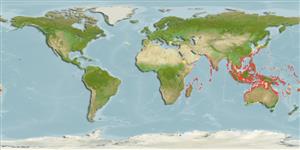Common names from other countries
Classification / Names / Names
Namen | Synonyme | Catalog of Fishes (gen., sp.) | ITIS | CoL | WoRMS
Environment: milieu / climate zone / depth range / distribution range
Ökologie
Demersal; tiefenbereich 6 - 40 m (Ref. 356). Tropical; 41°N - 58°S (Ref. 356)
Indo-West Pacific, Northwest Atlantic, and the Mediterranean Sea: Indo-Malayan Archipelago.
Length at first maturity / Size / Gewicht / Alter
Maturity: Lm ? range ? - ? cm Max length : 136 cm SVL Männchen/unbestimmt; (Ref. 2352)
Minimum depth from Ref. 101690. Widely spread in tropical reefs. Spends half of its lifetime on land but goes back to water to hunt for food. It then returns to small islets to digest its prey, mate and lay its eggs. Soft-bottom forager, targeting anguilliform fishes in cavities and burrows. Occupies the same trophic level as Laticauda saintgironsi (Ref. 101687). This species exhibits a more dynamic and complex predator-prey relationship with an anguilliform fish, its prey. Many conger or moray eels captured by sea kraits are likely to retaliate and bite sea kraits (considering krait versus prey body size), increasing the risk of injury on the sea krait's end as prey size increases, thus imposing difficulty on actual feeding (Ref. 118210).
Life cycle and mating behavior
Geschlechtsreife | Fortpflanzung | Ablaichen | Eier | Fecundity | Larven
Migrates on land to reproduce.
SAUP Database. 2006. (Ref. 356)
IUCN Rote Liste Status (Ref. 130435)
CITES Status (Ref. 108899)
Not Evaluated
Not Evaluated
Nutzung durch Menschen
| FishSource |
Tools
Mehr Information
Alter/Größe
Wachstum
Länge-Gewicht
Länge-Länge
Morphologie
Larven
Dichte
Internet Quellen
Estimates based on models
Preferred temperature
(Ref.
115969): 23 - 29.1, mean 28.1 (based on 1450 cells).
Preiskategorie
Unknown.
